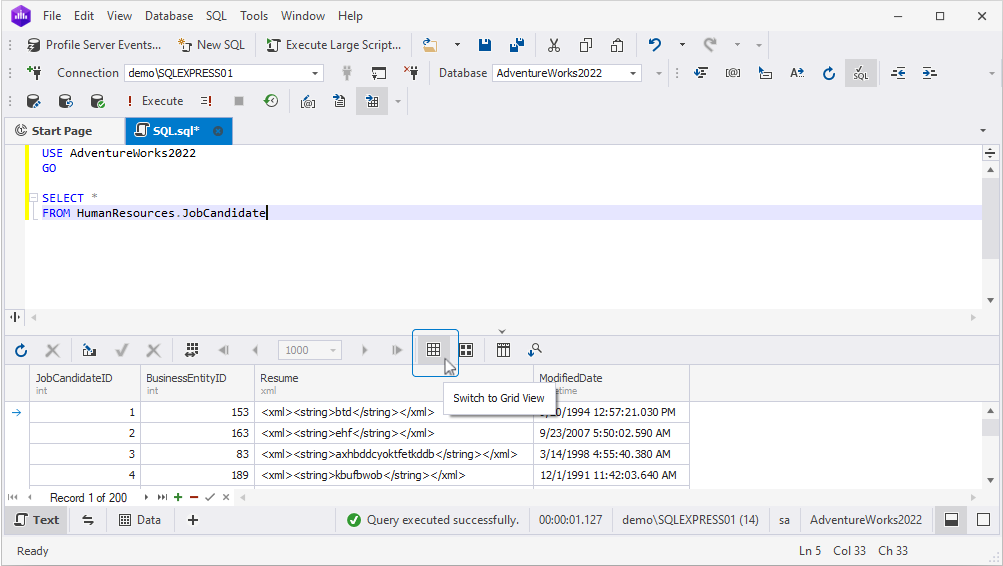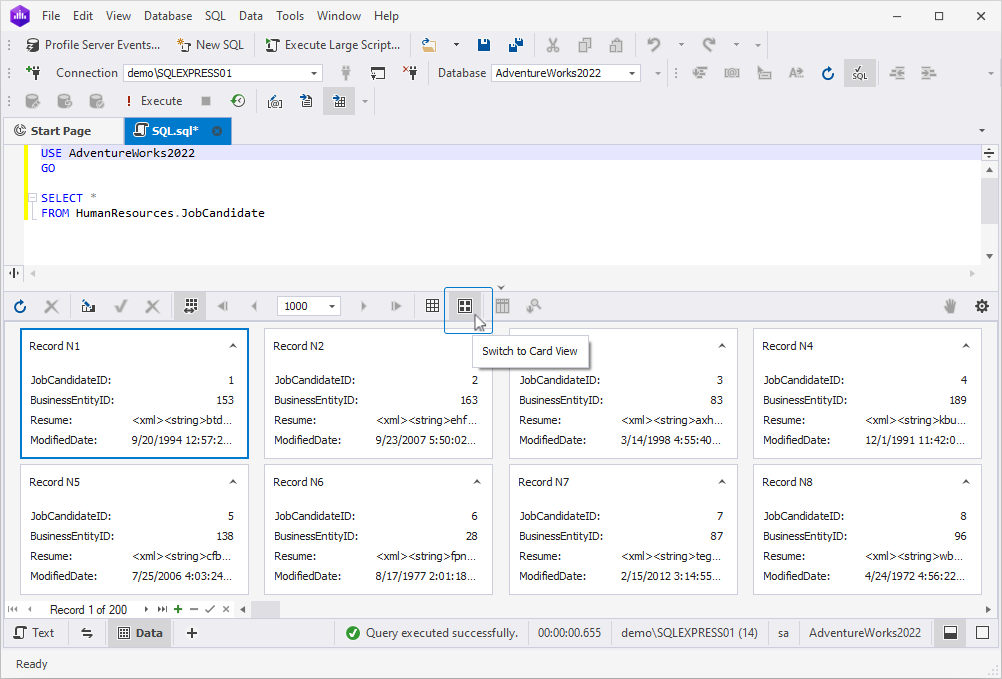SQL Document overview
When working with databases, a crucial aspect of your interaction involves writing and executing SQL queries. In the dbForge product line, the SQL document plays a pivotal role that gives you an opportunity to create SQL statements and subsequently execute them against the connected database server.
To create a new SQL Document:
1. On the standard toolbar, click New SQL.
2. In the Connect to Server that opens, choose the server you want to connect to and click Connect.
The empty SQL document opens where you can insert and update a SQL statement.
SQL document overview
Each SQL document includes different representations of the content: Text and Data document views.
- Text view comprises the SQL Editor, which allows you to write SQL statements.
- Data view, typically shown after a query is executed, comprises the Data Editor that displays the result sets returned by a database server.

To switch to a specific view:
- Click the view name at the bottom panel of the document.
- Right-click the bottom panel of the document to open the shortcut menu and select a view from the list.
Represent query execution results
In SQL Editor, the query execution results can be represented in two ways: Grid (default state) and Card Views.
Grid View
To represent results as a grid, click Switch to Grid View on the SQL Editor toolbar. The following image represents a sample of query execution results in a grid format.

Card View
To view the results as cards, click Switch to Card View on the SQL Editor toolbar. The following image represents a sample of query execution results in text format.

Document layout
SQL document has two types of view layout: Split Layout (default layout) and Combined Layout. To switch document layout, use the appropriate options at the bottom-right corner of the document.

Split Layout
In the split layout, a document is divided into two horizontal areas:
1. Text - the SQL document you are working with.
2. Data - the query execution result.
A document has the main view, which is aligned to the top of the document viewport, and additional views, which are displayed at the bottom area of the document viewport.
To swap the main view and active additional view, click ![]() Swap main and additional document views at the bottom of the SQL document.
Swap main and additional document views at the bottom of the SQL document.

Combined Layout
In the combined layout, you can see only one view at a time.

To switch between the document views, click Text or Data at the bottom of the SQL document.
Text selection
There are three ways to select a block of SQL code:
- Use the Shift + navigational keys, Page up, Page down, Home, and End.
- Use the Shift + Alt + navigational keys, Page up, Page down, Home, and End.
- Use the mouse.
Bookmarks
dbForge Event Profiler allows adding a bookmark to any part of your SQL document. This feature saves a particular line in the code and the cursor position.
To add a bookmark, on the standard toolbar, click Toggle a bookmark on the current line or press Ctrl+K, K.
![]()
To navigate the bookmarks:
- Click
 Move the caret to the previous bookmark or use the Ctrl+K, Ctrl+P keyboard shortcut.
Move the caret to the previous bookmark or use the Ctrl+K, Ctrl+P keyboard shortcut. - Click
 Move the caret to the next bookmark or use the Ctrl+K, Ctrl+N keyboard shortcut.
Move the caret to the next bookmark or use the Ctrl+K, Ctrl+N keyboard shortcut.
To delete bookmarks in the current document, click  Clear all bookmarks in the current document or press Ctrl+K, L.
Clear all bookmarks in the current document or press Ctrl+K, L.
Code folding
If you are working with a large script, you might need to collapse some of the clauses for convenience. Hovering over the collapsed clause will display its content.

Status bar
The status bar contains the most important information regarding the current connection and query execution.

where:
- Development is an environment category
- Connected is a connection status
- DBFSQLSRV\SQL2022(16) is a host (server version)
- sa is a username
- AdventureWorks2022 is a selected database
When you execute a query, the query execution status and the query execution time will be displayed in the status bar.

- Development is an environment category
- Query executed successfully is a query execution status
- 00:00:00.438 is the execution time
- DBFSQLSRV\SQL2022(16) is a host (server version)
- sa is a username
- AdventureWorks2022 is a selected database
Comment the code
To comment on the part of the SQL code, select it and click Comment out the selected lines on the standard toolbar. Alternatively, press CTRL+K, C.

To uncomment a section, select it and click Uncomment the selected lines on the standard toolbar or use the CTRL+K, U keyboard shortcut.
